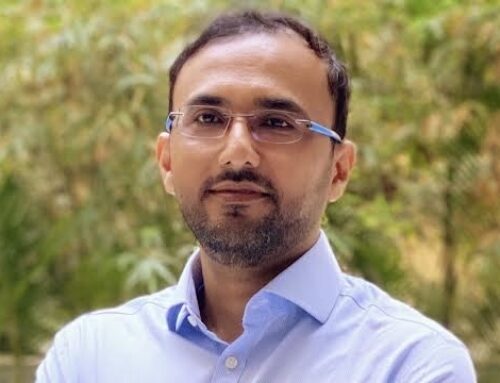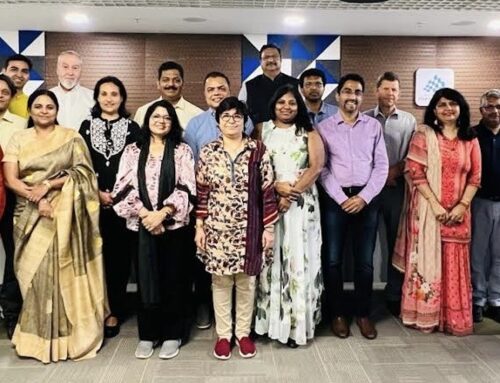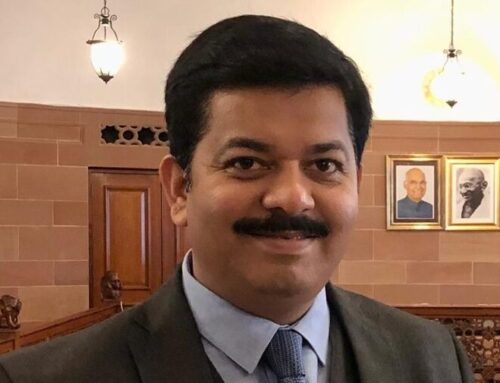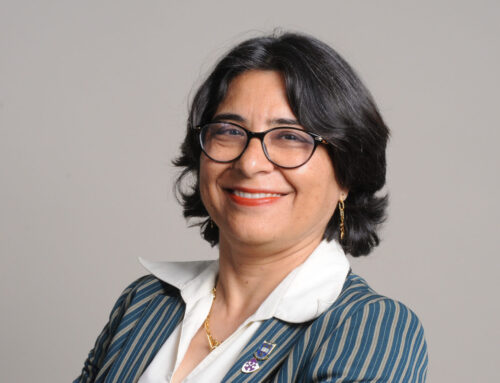John Hoffmire: I love your Twitter tag: “A scientist who makes serious research fun.” Tell me about your recent research and what is fun about it?
Beena: First, to me what makes research fun is that one gets to follow one’s curiosity. As a scientist, I’ll take on a challenge and then use my curiosity and creatively to come up with and design a solution. What could be more fun than that. There is a lot more creativity involved in scientific research than most people realize.
To give you an example, one of the current projects that my team is working on is creating a digital twin of human skin. We have built a digital model of human skin that will benefit the pharmaceutical and cosmetic industries. They will use our digital model as a way to simulate drug delivery or test cosmetics thereby reducing the need for animal testing. While building a realistic bio-physical model of skin required complex algorithms, we made it more fun by bringing in virtual reality (VR) technology to view the outcomes of simulations.
John: If you will, tell me more about that.
Beena: The TCS Digital Skin Twin Platform uses multiscale modeling and VR for transdermal pharmaceutical and cosmetics delivery. The platform is capable of micro- and macro-scale modeling, and can emulate the physicochemical properties of human skin, thereby facilitating the study of how constituents of new formulations are transported through its layers. This digital skin has been extensively validated by TCS COIN™ partners, and has been seen to work like real skin as compared to in-vivo/in-vitro experiments. The platform also uses a VR-based tool for advanced visualization and collaboration over the cloud. From simulations that leverage molecular dynamics and computational fluid dynamics, to being adept at nanoparticle design, the platform is capable of enhancing current developmental processes significantly.
John: I think our readers will understand what you just said. But, just in case, and to fill out the story a little more, can you say more, in non-scientific language, about the significance of digital skin.
Beena: The pharmaceutical and cosmetic industries care for skin to the tune of multi billions of dollars. Before launching any products into the market, companies must conduct numerous experiments to test their skin products and ensure their safety and efficacy. These experiments are carried out on animals, and that can often lead to their death. And only about 10-20% of the products tested reach the market, partly because animal-based models don’t always work well for humans.
Scientists at TCS Research are trying to solve this problem by developing a digital model of the human skin. This could change the way pharma and skin care products are developed and eliminate the need for animal testing.
Additionally, TCS Research’s Digital Skin project is working toward development of multi-scale models of skin layers. This enables in-silico/digital testing of numerous combinations of drug and cosmetic formulations, thereby expanding the search space and accelerating drug and cosmetic development. Through this process, we can also help deliver drugs painlessly through the skin, rather than through pills, injections or other invasive methods.
John: You’ve built much of your career on computational material science, especially molecular modeling based design and development of materials and chemicals for various industrial applications. Explain that to a nonscientist.
Beena: If you think about traditional materials being used by us today such as fabrics, metals, ceramics, glasses, plastics, paints and coatings, drugs, cosmetics, composites and so on, all were discovered through trial and error experiments, often even by accident. However, molecular simulations and their application to materials science have allowed, for the first time in human history, the development of made-to order materials designed atom by atom.
At TCS Research, we have employed molecular simulations to unravel complex molecular interactions between various constituents of multi-component systems. We have developed novel solutions for many industries including mineral processing, cement, paints and coatings, lubricants, ceramics, agrochemicals, pharmaceuticals, and personal care products – all utilizing our molecular modeling paradigm.
John: You were a recipient of a prestigious scholarship to be part of the Chevening Research Science and Innovation Leadership Programme (CRISP) at Said Business School, University of Oxford, UK. Explain to us what you did as part of that fellowship.
Beena: In 2012, I was a fellow in the Chevening Research Science and Innovation Leadership Programme (CRISP). As the name suggests, for twelve weeks I was immersed in classes and fields trips that spotlighted science, innovation, leadership, and management, as well as wider issues including global challenges, politics, and international relations. I met such extraordinary colleagues and leaders from a wide variety of fields and from all over India. My time with them, as well as the professors and professionals, who taught and organized the program and activities, challenged me to think about my work and influence in all sorts of new ways. My time in the CRISP program shaped my professional development profoundly. And that influence continues as I stay in touch with some of my colleagues and professors.
John: I could go on for hours and ask you about your close to 150 research papers in reputed journals and given at conferences, as well as 90 patent/patent applications to your credit. For now, I’ll end by saying thank you for catching me up in a small way on what you’ve been since you were in Oxford. I was impressed with you when I met you all those years ago and I’m even more impressed now, when I see what you have been working on since then. I wish you continued success in your endeavors. Keep in touch.
Beena: Thank you, John. It’s been a pleasure. I’m always happy to stay connected to the Chevening CRISP programme and to encourage young people, and especially young women to pursue a career in science. Serious research really can by fun
Dr. Beena Rai is a Chief Scientist & Head, Physical Sciences at TCS Research, Tata Consultancy Services. She is also an alum of the Chevening Research Science and Innovation Leadership Fellowship (CRISP) program at Oxford University (2012)
Interviewer: Dr. John Hoffmire is the Chairman of the Center on Business and Poverty, and Research Associate at the Oxford Centre for Mutual and Co-owned Business
Click here for more information on TCS Digital Skin Twin Platform





